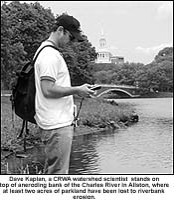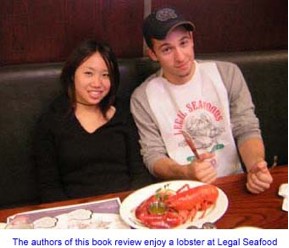By Bruce Wenning/ Special To The Tab
Last fall did you loose a lot of your precious tulip bulbs to the gray squirrel (Sciurus carolinensis), chipmunk (Tamias striatus), and meadow vole (Microtus pennsylvanicus)? I did at Habitat, the Mass Audubon sanctuary in Belmont where I'm the grounds manager. We plant 2,000 tulip bulbs every November for beautifying our formal gardens each spring. Last fall we lost close to 600 tulip bulbs to the above mentioned rodents. They were dug up and eatened for a highly nutrious meal and adequate moisture source during the droughty weather that prevailed. The meadow vole was very successful at feeding on our tulip bulbs even under the pristine snow cover. Those bandits!
 What caused this change in feeding behavior to become so drastic and satisfying to them and troublesome to gardeners? The droughty years that began in 1993 and lasted more or less until 2004. Acorns are the fruits (and seeds) of oak trees and the main staple of squirrels while still on the tree. The calories stored in acorns is in the form of fat and other organic compounds that help squirrels, and other animals, get through the winter months. Squirrels prefer to feed immediately on the acorns of White Oak (Quercus alba) and will bury the high tannin content acorns of Red Oak (Q. rubra) and Black Oak (Q. velutina) for eating at a later date. Acorns are buried at shallow depths for better olfactory detection. Experiments have proven that squirrels find their buried acorns by smelling them and not by memory.
What caused this change in feeding behavior to become so drastic and satisfying to them and troublesome to gardeners? The droughty years that began in 1993 and lasted more or less until 2004. Acorns are the fruits (and seeds) of oak trees and the main staple of squirrels while still on the tree. The calories stored in acorns is in the form of fat and other organic compounds that help squirrels, and other animals, get through the winter months. Squirrels prefer to feed immediately on the acorns of White Oak (Quercus alba) and will bury the high tannin content acorns of Red Oak (Q. rubra) and Black Oak (Q. velutina) for eating at a later date. Acorns are buried at shallow depths for better olfactory detection. Experiments have proven that squirrels find their buried acorns by smelling them and not by memory.
During droughty years, oak trees, as other tree species, become stressed due to a lack of adequate water for growth and reproduction. Part of an oak trees carbohydrate root reserves are allocated to the reproductive cycle of the tree each year. When plants are stressed by un-seasonal temperature extremes, nutrient deficiencies or prolonged drought, particularly during their flower development and pollen dispersal, seed production can be greatly reduced. During drought the threat of death increases which prompts many trees to allocate close to 50 percent of these reserves to leaf and root production to ensure survival and away from energy depleting reproduction (producing seeds). This was the scenario last fall with oak trees. Successive years of prolonged drought shifted these reserves away from acorn production. The acorn population simply crashed. In addition, when drought occurs early in the growing season the flowers of oaks are fed upon by squirrels preventing their fate of development into acorns in the fall. Therefore, drought was the culprit that turned the squirrels, chipmunks and voles from acorns and other natural foods to tulip bulbs. Tulip gardens showed the damage this past spring with incomplete blooms or no tulip flowers at all.
This year I see acorns! Hopefully, many of our rodent friends will spare our tulip bulbs and stick with their natural foods. To protect tulip bulbs from squirrels and other rodents, I have found two non-toxic strategies. The first is covering your tulip bulb beds with unsightly hardware cloth (wire) with quarter inch holes. Secure the edges with bricks, logs or other heavy objects. Planting your tulip bulbs closer to Thanksgiving gives squirrels and chipmunks more time away from your attractive tulip bulbs and more time caching acorns and other nuts and seeds.
The second strategy is spring protection. When tulips are emerging from the soil, apply a wax-based hot pepper spray to the foliage to deter rabbits, squirrels and chipmunks from seeking moisture by nibbling the tulip stems that support the bloom.
There are hot pepper spray concoctions on the market, but not wax-based. To buy the longer lasting wax-based pepper spray contact Ben E. Daniels Company in Plympton, MA. www.benedaniels.com, (800)-854-7988. I have tried this spray and it works.
Bruce Wenning, a plant pathologist and entomologist, is property manager of MA Audubon Society's Habitat Education Center and Wildlife Sanctuary (Belmont). He is on the Board of Directors of the Ecological Landscaping Association, www.ecolandscaping.org.
 "CRWA, known for its work in protecting, preserving and enhancing the Charles River and its watershed, is creating a new approach to urban redevelopment," said Bob Zimmerman, executive director of Charles River Watershed Association. "We want to build 'blue cities' - cities that are designed to sustain and restore water resources."
"CRWA, known for its work in protecting, preserving and enhancing the Charles River and its watershed, is creating a new approach to urban redevelopment," said Bob Zimmerman, executive director of Charles River Watershed Association. "We want to build 'blue cities' - cities that are designed to sustain and restore water resources." Trevor Corson's "The Secret Life of Lobsters" offers an intellectual awakening on an anecdotal plate. He interweaves stories of lobstermen and scientists, offering a hint of the friction between the two groups, while demonstrating their common love of lobsters. Having spent his childhood summers on Little Cranberry Island, Corson developed an early interest in lobstering and he gained a general appreciation of the village's economic dependence on the lobster industry. Later in his life, he spent two years working full-time aboard a lobster boat and gained a much deeper appreciation of lobstering: "I wanted to be a marine biologist when I grew up, but also a commercial fisherman."
Trevor Corson's "The Secret Life of Lobsters" offers an intellectual awakening on an anecdotal plate. He interweaves stories of lobstermen and scientists, offering a hint of the friction between the two groups, while demonstrating their common love of lobsters. Having spent his childhood summers on Little Cranberry Island, Corson developed an early interest in lobstering and he gained a general appreciation of the village's economic dependence on the lobster industry. Later in his life, he spent two years working full-time aboard a lobster boat and gained a much deeper appreciation of lobstering: "I wanted to be a marine biologist when I grew up, but also a commercial fisherman." 